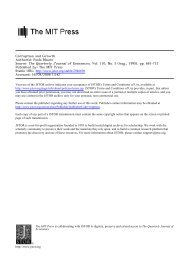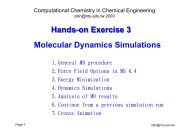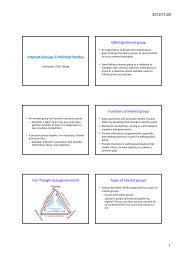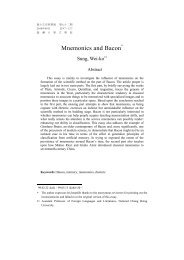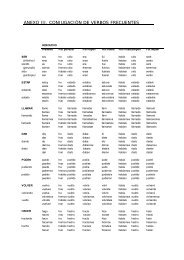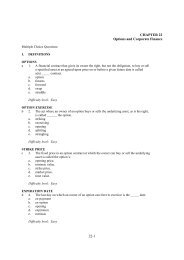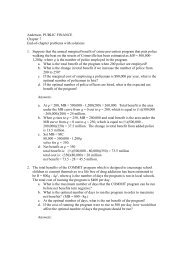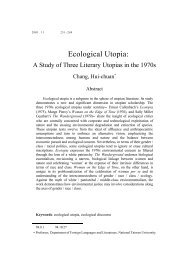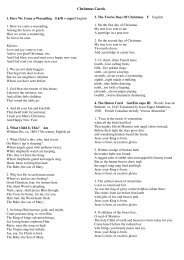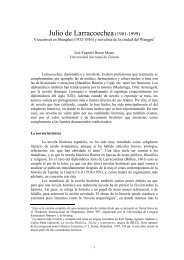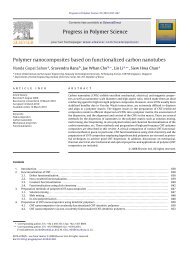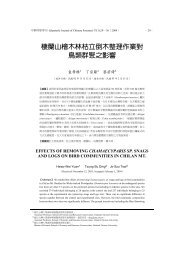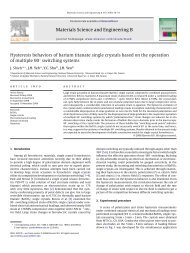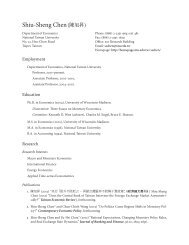Chapter 5 A Closed-Economy One-Period Macroeconomic Model
Chapter 5 A Closed-Economy One-Period Macroeconomic Model
Chapter 5 A Closed-Economy One-Period Macroeconomic Model
You also want an ePaper? Increase the reach of your titles
YUMPU automatically turns print PDFs into web optimized ePapers that Google loves.
<strong>Chapter</strong> 5<br />
A <strong>Closed</strong>-<strong>Economy</strong> <strong>One</strong>-<strong>Period</strong><br />
<strong>Macroeconomic</strong> <strong>Model</strong><br />
Teaching Goals<br />
There are three key points to be learned from this chapter. The first point is that when we allow the<br />
consumers and firms that we studied in <strong>Chapter</strong> 4 to interact with each other and with the government, the<br />
economy is able to achieve equilibrium through price adjustment. In this particular case, the “price” is the<br />
relative price of leisure, the real wage. The second important point is that the equilibrium that markets settle<br />
upon is a favorable one, in the sense of Pareto optimality. This point is in keeping with Adam Smith’s notion<br />
that the “invisible hand” of self-interested individuals, meeting in a competitive market, can work for the<br />
common good. The third point is that we can directly discover the equilibrium position of a market economy<br />
by solving an economic planner problem. Although students may find this point to be somewhat arcane,<br />
stress the point that it will be much simpler to solve problems (e.g., exam problems) by working with a<br />
planner problem as opposed to directly solving general equilibrium problems. The students, however, need to<br />
be aware when this solution method is not applicable. The new section about the Laffer curve is a good way<br />
to show when social and private optima do not coincide.<br />
Once students have mastered the mechanics of the model, the two problems for which this model is best<br />
suited are the analyses of changes in government spending and total factor productivity. In working these<br />
problems, stress the applicability of these results to historical applications and as a guide to understanding<br />
current events.<br />
A key tactic of the textbook’s approach is the critical assessment of the usefulness and credibility of<br />
competing models. Therefore, it is important to stress the extent to which models fit the facts. Does this<br />
model fit the facts of long-run growth? Does this model fit the facts of the typical business cycle? These<br />
kinds of questions come up again and again in the course of macroeconomic study. Stress again and again<br />
that scientific study needs to relate to observations, in our case the stylized facts of <strong>Chapter</strong> 2.<br />
Classroom Discussion Topics<br />
An alternative approach to this material is to start with the example of Robinson Crusoe (or Castaway,<br />
Gilligan’s Island, etc.). Does an isolated individual have any economic choices? What would guide these<br />
choices? Would you rather be on an island with a more plentiful food supply? A pure income effect can<br />
then be presented in the form of extra food (or a volleyball) washing up on shore, or in the form of<br />
“pirates” (government?) demanding tribute. An increase in total factor productivity can be in the form of<br />
obtaining a fishing net or a ladder to climb coconut trees. A change in capital can be the consequence of a<br />
hurricane, etc.<br />
The next step would be to ask the students about the likely consequences of additional individuals on the<br />
island. If they are all identical, and there are no economies to team production, will there be any reason for<br />
markets to exist? Could a market improve things? How and why? Typically, markets improve things only<br />
to the extent that people are different. However, these types of differences are what we are willing to<br />
ignore when we adopt the fiction of a representative consumer.
Outline<br />
<strong>Chapter</strong> 5 A <strong>Closed</strong>-<strong>Economy</strong> <strong>One</strong>-<strong>Period</strong> <strong>Macroeconomic</strong> <strong>Model</strong> 43<br />
I. Competitive Equilibrium<br />
A. A <strong>One</strong>-<strong>Period</strong> <strong>Model</strong><br />
1. No Borrowing or Lending<br />
2. G = T<br />
B. Equilibrium <strong>Model</strong>ing<br />
1. Endogenous Variables<br />
2. Exogenous Variables<br />
3. Hypothetical Experiments<br />
C. Properties of a Competitive Equilibrium<br />
1. Representative Consumer Maximizes Utility Subject to Budget Constraint<br />
2. Representative Firm Maximizes Profits<br />
3. Markets Clear<br />
4. Government Budget Constraint Satisfied<br />
w= MRS = MRT = MP<br />
5. lC , lC , N<br />
II. Optimality<br />
A. Pareto Optimality<br />
B. Welfare Theorems<br />
1. 1st Theorem: A Competitive Equilibrium Can Be Pareto Optimal<br />
2. 2nd Theorem: A Pareto Optimum Can Be a Competitive Equilibrium<br />
C. Inefficiencies<br />
1. Externalities<br />
2. Distorting Taxes<br />
3. Monopoly Power<br />
D. Using the Second Theorem<br />
1. Pareto Optima Are Easier to Identify<br />
2. Effects of Disturbances on Pareto Optima<br />
III. Effects of an Increase in Government Spending<br />
A. Impact Effect<br />
1. Parallel Downward Shift in PPF<br />
2. Pure Income Effect<br />
B. Equilibrium Effects<br />
1. Reduced Consumption<br />
2. Reduced Leisure and Increased Hours of Work<br />
3. Increased Output<br />
4. Lower Real Wage<br />
C. Crowding-Out<br />
D. Government Spending a Source of Business Cycles?<br />
1. Government Spending Shocks Wrongly Predict Countercyclical Consumption<br />
2. Government Spending Shocks Wrongly Predict Countercyclical Real Wages
44 Williamson <strong>Macroeconomic</strong>s, Third Edition<br />
IV. Effects of an Increase in Total Factor Productivity<br />
A. Impact Effect<br />
1. Upward Shift in PPF<br />
2. Steeper PPF<br />
3. Income and Substitution Effects<br />
B. Equilibrium Effects<br />
1. Increased Consumption<br />
2. Leisure and Hours Worked May Rise or Fall<br />
3. Increased Output<br />
4. Higher Real Wage<br />
C. Productivity and Long-Run Growth<br />
1. Consumption Grows over Time<br />
2. Hours Worked Remain about Constant<br />
3. Output Increases over Time<br />
4. Real Wages Rise over Time<br />
D. Productivity as Source of Business Cycles?<br />
1. Consumption Is Procyclical<br />
2. Cyclical Properties of Hours Worked<br />
a. Procyclical Hours Worked Is a Business Cycle Fact<br />
b. Need Strong Substitution Effect to Predict Procyclical Hours<br />
c. Intertemporal Substitution of Leisure<br />
3. Increased Output Defines the Cycle<br />
4. Procyclical Real Wage Rate<br />
V. Income Tax Revenue and the Laffer Curve<br />
A. Tax Revenue<br />
1. The Tax Base Depends on the Proportional Tax Rate<br />
2. The Laffer Curve Measures Tax Revenue as a Function of the Tax Rate<br />
3. Unless the Tax Rate Is Optimal, Two Tax Rates Yield the Same Tax Revenue<br />
4. Supply-Side Economists Claim the U.S. <strong>Economy</strong> Is at the Bad Tax Rate<br />
5. Empirical Evidence Tends to Prove Supply-Side Economists Wrong<br />
Textbook Question Solutions<br />
Questions for Review<br />
1. A closed economy is easier to work with. Opening the economy does not change most of the<br />
properties of an economy. The closed economy is the correct model for the world as a whole.<br />
2. Government levies taxes and purchases consumption goods.<br />
3. In a one-period model, there can be no borrowing or lending. There is therefore no way to finance a<br />
government deficit.<br />
4. Endogenous variables: C, N s<br />
, N d<br />
, T, Y, and w.<br />
5. Exogenous variables: G, z, K.
6. The representative consumer chooses C and N s to maximize utility.<br />
The representative firm chooses N d to maximize profits.<br />
s d<br />
Market-clearing: N = N = N.<br />
Government budget constraint: T = G.<br />
<strong>Chapter</strong> 5 A <strong>Closed</strong>-<strong>Economy</strong> <strong>One</strong>-<strong>Period</strong> <strong>Macroeconomic</strong> <strong>Model</strong> 45<br />
7. The slope of the production possibilities frontier is equal to − MPN<br />
. The slope of the production<br />
possibilities frontier is also identified as − MRTlC<br />
, , where MRT lC , is identified as the marginal rate of<br />
transformation between leisure and consumption.<br />
8. The competitive equilibrium is Pareto optimal because it lies at a tangency point between the<br />
production possibilities frontier and a representative consumer’s indifference curve.<br />
9. The first theorem: A competitive equilibrium can be Pareto optimal. This theorem assures us that the<br />
competitive equilibrium is a good outcome. The second theorem: A Pareto optimum is a competitive<br />
equilibrium. This theorem allows us to directly analyze Pareto optima with the assurance that these<br />
points are also competitive equilibriums. The second theorem is useful because Pareto Optima are<br />
often easier to work with than competitive equilibriums.<br />
10. Externalities, noncompetitive behavior, and distorting taxes.<br />
11. G↑⇒Y ↑, C↓, N ↑, l↓, and w↓<br />
.<br />
12. Government competes with the private sector in buying goods. An increase in government spending<br />
implies a negative wealth effect, which results in lower consumption.<br />
13. z↑⇒Y ↑, C↑, and w↑<br />
. The sign of the effects on N and l are ambiguous.<br />
14. The substitution effect of an increase in z is that the representative consumer works more hours. The<br />
income effect of an increase in z is that the representative household works more hours. The sign of<br />
the net effect is ambiguous.<br />
15. A distorting tax makes that households equalize their marginal rate of substitution between leisure<br />
and consumption to the after tax wage, which is different from the before tax wage that firms equalize<br />
their marginal rate of transformation to. Thus, one cannot achieve the Pareto optimum where the<br />
same wage (before tax) is equal to both marginal rates above.<br />
16. The Laffer curve takes into account that higher proportional tax rates give incentives to households to<br />
work less. While tax revenue increases with the tax rate for a given tax base, that tax base is reduced<br />
by the tax rate.<br />
17. When the income tax rate falls, households are willing to supply additional labor more in such<br />
quantities that the tax base increases more than what the tax rate decreases, thus increasing tax<br />
revenue.
46 Williamson <strong>Macroeconomic</strong>s, Third Edition<br />
Problems<br />
1. Although we often think about the negative externalities of congestion and pollution in cities, there<br />
may also be some positive externalities. A concentrated population is better able to support the arts<br />
and professional sports; cities typically have a greater variety of good restaurants, etc. Perhaps a more<br />
basic issue is that there may be some increasing returns to scale at low output levels that make<br />
industrial production more costly in small towns. There may also be externalities in production in<br />
being located close to other producers. <strong>One</strong> example would be the financial industry in financial<br />
centers like New York, London, Tokyo, etc. Another example would be large city medical centers<br />
that enhance coordination between primary physicians and specialists.<br />
<strong>One</strong> market test of whether productivity is higher in cities would be to look at the wages in cities<br />
versus the wages in smaller towns and rural areas. Wages are often higher in cities for individuals of<br />
comparable skills. Market efficiency suggests that the higher wages be reflective of a higher marginal<br />
product of labor, and that the higher wages compensate those choosing to live in cities for the<br />
negative externalities that they face.<br />
2. In a one period model, taxes must be exactly equal to government spending. A reduction in taxes is<br />
therefore equivalent to a reduction in government spending. The result is exactly opposite of the case<br />
of an increase in government spending that is presented in the text. A reduction in government<br />
spending induces a pure income effect that induces the consumer to consume more and work less. At<br />
lower employment, the equilibrium real wage is higher because the marginal product of labor rises<br />
when employment falls. Output falls, consumption rises, employment falls and the real wage rises.<br />
3. The only impact effect of this disturbance is to lower the capital stock. Therefore, the production<br />
possibility frontier shifts down and the marginal product of labor falls (PPF is flatter).<br />
(a) The reduction in the capital stock is depicted in the figure below. The economy starts at point A<br />
on PPF 1 . The reduction in the capital stock shifts the production possibilities frontier to PPF 2 .<br />
Because PPF 2 is flatter, there is a substitution effect that moves the consumer to point D. The<br />
consumer consumes less of the consumption good and consumes more leisure. Less leisure also<br />
means that the consumer works more. Because the production possibilities frontier shifts down,<br />
there is also an income effect. The income effect implies less consumption and less leisure (more<br />
work). On net, consumption must fall, but leisure could decrease, remain the same, or increase,<br />
depending on the relative strengths of the income and substitution effect. The real wage must also<br />
fall. To see this, we must remember that, in equilibrium, the real wage must equal the marginal<br />
rate of substitution. The substitution effect implies a lower marginal rate of substitution. The<br />
income effect is a parallel shift in the production possibilities frontier. As the income effect<br />
increases the amount of employment, marginal product of labor must fall from point D to<br />
point B. This reinforces the reduction in the marginal rate of substitution from point A to point D.
<strong>Chapter</strong> 5 A <strong>Closed</strong>-<strong>Economy</strong> <strong>One</strong>-<strong>Period</strong> <strong>Macroeconomic</strong> <strong>Model</strong> 47<br />
(b) Changes in the capital stock are not likely candidates for the source of the typical business cycle.<br />
While it is easy to construct examples of precipitous declines in capital, it is more difficult to<br />
imagine sudden increases in the capital stock. The capital stock usually trends upward, and this<br />
upward trend is important for economic growth. However, the amount of new capital generated<br />
by a higher level of investment over the course of a few quarters, of a few years, is very small in<br />
comparison to the existing stock of capital. On the other hand, a natural disaster that decreases<br />
the stock of capital implies lower output and consumption, and also implies lower real wages,<br />
which are all features of the typical business cycle contraction.<br />
4. Government Productivity. First consider the benchmark case in which z = 1, and there is no effect of<br />
changes in z on government activities. Now suppose that z increases. This case of an increase in z is<br />
depicted in the figure below. The original production possibilities frontier is labeled PPF and the<br />
1<br />
competitive equilibrium is at point A. If the increase in z only affects the economy through the<br />
change in zF( KN , ), then the new production possibilities frontier is PPF . The diagram shows a<br />
2<br />
case in which the income and substitution effects on leisure exactly cancel out, and the economy<br />
moves to point B. The equation for the production possibilities frontier is C = zF( K, h−l) − T.<br />
In the<br />
benchmark case, T = G and so we have C = zF( K, h−l) − G.<br />
For this problem, T = G/ z,<br />
and so the<br />
production possibilities frontier is given by C = zF( K, h−l) − G/ z.<br />
When z = 1, the two PPFs<br />
coincide. When z increases, the vertical intercept of the PPF increases by G/ Δ z.<br />
Therefore, the new<br />
PPF is PPF in the figure below. The competitive equilibrium is at point C. There is an additional<br />
3<br />
income effect that provides an additional increase in equilibrium consumption, and a reinforced<br />
income effect that tend to make leisure increase. Therefore, relative to the benchmark case, there is a<br />
larger increase in consumption, and either a smaller decrease in leisure or a larger increase in leisure.
48 Williamson <strong>Macroeconomic</strong>s, Third Edition<br />
5. Change in preferences.<br />
(a) At the margin, the consumer decides that leisure is more preferred to consumption. That is, the<br />
consumer now requires a bigger increase in consumption to willingly work more (consume less<br />
leisure). In more intuitive language, the consumer is lazier.<br />
(b) To work out the effects of this change in tastes, we refer to the figure below. The production<br />
possibility frontier in this example is unchanged. The consumer now picks a new point at which<br />
one of the flatter indifference curves is tangent to the production possibilities frontier. That is,<br />
equilibrium will shift from point A to point B. Consumption falls and leisure rises. Therefore, the<br />
consumer works less and produces less. Because employment has fallen, it also must be the case<br />
that the real wage increases.<br />
(c) This disturbance, which some might characterize as a contagious outbreak of laziness, would<br />
have the appearance of a recession, as output and employment both fall. The consequent<br />
reduction in consumption is also consistent with a typical recession. However, in this case the<br />
real wage would rise, which is inconsistent with the business cycle facts. Therefore, this type of<br />
preference change is not a cause of recessions.
<strong>Chapter</strong> 5 A <strong>Closed</strong>-<strong>Economy</strong> <strong>One</strong>-<strong>Period</strong> <strong>Macroeconomic</strong> <strong>Model</strong> 49<br />
6. Production-enhancing aspects of government spending.<br />
(a) The increase in government spending in this example has two separate effects on the production<br />
possibilities frontier. First, the increase in government spending from G 1 to G 2 implies a parallel<br />
downward shift in the production possibilities frontier. Second, the productive nature of<br />
government spending is equivalent to an increase in total factor productivity that shifts the<br />
production possibilities frontier upward and increases its slope. The figure below draws the<br />
original production possibilities frontier as PPF 1 and the new production possibilities frontier as<br />
PPF 2 . If the production-enhancing aspects of the increase in government spending are large<br />
enough, representative consumer utility could rise, as in this figure.<br />
(b) There are three effects at work in this example. First, there is a negative income effect from the<br />
increase in taxes needed to pay for the increased government spending. This effect tends to lower<br />
both consumption and leisure. Second, there is a substitution effect due to the productive effect<br />
of the increase in G, which is drawn as the movement from point A to point D. This effect tends<br />
to increase both consumption and leisure. Third, there is a positive income effect from the<br />
increase in G on productivity. This effect tends to increase both consumption and leisure. In the<br />
figure above, the movement from point D to point B is the net effect of the two income effects. In<br />
general, consumption may rise or fall, and leisure may rise or fall. The overall effect on output is<br />
the same as in any increase in total factor productivity. Output surely rises.
50 Williamson <strong>Macroeconomic</strong>s, Third Edition<br />
7. The fact that government spending make firms more productive is similar to adding G to the<br />
production function. There are now two effects to an increase in government expenses: the standard<br />
crowding out of consumption, and now also an efficiency effect on production.<br />
(a) The figure below illustrates a particular situation where the welfare of the household is improved,<br />
as illustrated by a shift to the north-east of the indifference curve. The equilibrium shifts from<br />
A to B as the PPF is lowered by the additional government expenses but is also getting steeper<br />
thanks to the same government expenses.<br />
(b) From previous results, we know that output increases with the increase in government expenses.<br />
This is now reinforced as G increases production efficiency. Regarding consumption and leisure,<br />
without this new effect, we obtained that an increase in G lead to a negative income effect and<br />
thus to decreases in both consumption and leisure. But as the real wage went down, there was<br />
also a substitution effect leading to an additional decrease in consumption and increase in leisure.<br />
The new effect on the production function adds opposite effects: a positive income effect and a<br />
wage increase, thus possibly reversing, or not, anything that was concluded without the impact of<br />
G on production.
<strong>Chapter</strong> 5 A <strong>Closed</strong>-<strong>Economy</strong> <strong>One</strong>-<strong>Period</strong> <strong>Macroeconomic</strong> <strong>Model</strong> 51<br />
8. We need to analyze each case separately. Start with the good equilibrium. As government expenses<br />
increase, more tax revenue needs to be raised, and thus the tax rate needs to be increased. As shown<br />
in the figure below, this tilts down the linear PPF. The new equilibrium leads to a lower indifference<br />
curve. This leads to a negative income effect and a lower wage (remember, it is z(1 − t)), thus a<br />
substitution effect. The income effect lowers consumption and leisure, the substitution effect<br />
decreases consumption and increases leisure. All in all, consumption is lower and leisure is higher, as<br />
we know that the substitution effect dominates the income effect. This means that the labor supply is<br />
reduced, and thus equilibrium labor and output.<br />
The story is different in the bad equilibrium. To increase tax revenue, one needs to reduce the tax<br />
rate. Then all the changes discussed above are exactly in the opposite direction.<br />
9. We know from previous analysis that an improvement in total factor productivity pushes up the PPF,<br />
and thus leads to an increase in consumption, a decrease in leisure, and thus an increase in the<br />
quantity of labor supplied. This increases the tax base, and thus allows to reduce the tax rate to<br />
achieve the same tax revenue, or in other words, it pushes the left portion of the Laffer curve to the<br />
left. The reduction in the tax rate has then a further impact on the variables of interest: as we saw<br />
in question 7, first part with a reversal of all signs: consumption increases even more and leisure<br />
decrease yet more, leading to an even higher quantity of labor. All in all, as both labor and total factor<br />
productivity increase, output increases.



